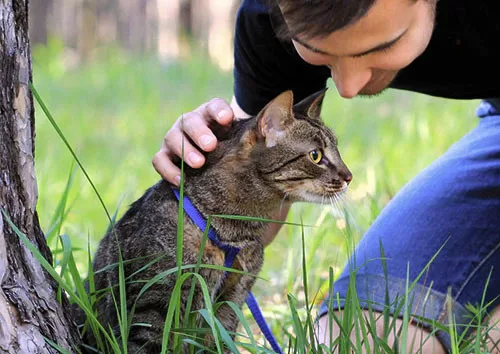Introduction to cat training
Did you know that it is possible to train a cat? Many people believe that only dogs can be trained, but this is not true! Cats can also learn commands and desirable behaviors. Cat training brings many benefits to these very special felines.
By training your cat, you will be strengthening the bond between you and promoting a more harmonious coexistence. Cats are animals by nature, but with proper training, they can become even more sociable and obedient. In addition, starting training from an early age is essential to ensure better results.
Here in this Purina One-sponsored article, we’re going to explore training techniques for your cat. Find out how to teach your feline to respond to basic commands and how to deal with unwanted behavior. Prepare to be amazed by the abilities of cats when it comes to training!
So let’s go! Follow this article and discover everything about the wonderful world of cat training.
Myths and truths about training cats

Cats are impossible to train: myth or truth?
Cats are often considered independent and stubborn animals, which leads some people to believe that they are impossible to train. However, this is just a myth. While it’s true that cats have a unique personality compared to dogs, they can still learn basic commands and develop skills through proper training.
Patience is key in the training process.
Unlike dogs, who are generally more receptive to training, cats may require a little more patience during the training process. It is important to understand that each cat has its own pace and personality. Some can learn quickly, while others may need more time to get used to training techniques.
Is training a cat just a matter of rewards and punishments?
While rewards and punishments can play an important role in cat training, it’s not just a matter of that. Cats respond best to positive approaches based on positive reinforcement. Rewarding them when they correctly perform a command or demonstrate desirable behaviors can help strengthen these positive associations.
What skills can cats be taught?
There are several skills that can be taught to cats through proper training. Some examples include:
- Using the litter box: it is possible to teach cats to use the litter box correctly, thus avoiding hygiene problems inside the house.
- Come when called: Although cats are known for their independence, it is possible to train them to come to you when called by name.
- Don’t Scratch Furniture: Through training, cats can learn where scratching is allowed and avoid damaging furniture and unwanted objects.
When training a cat, it is important to remember that each animal is unique. Some cats may be more amenable to training than others, but that doesn’t mean they’re impossible to train. With patience, proper techniques and positive reinforcement, it is possible to teach our feline friends important skills.
So the next time someone says that cats are impossible to house-train, remember to share the truths about training these amazing animals. Cats are intelligent animals and can learn many things if we teach them with love and dedication.
How to train a cat: essential tips

Establish a consistent routine for training your cat
Training a cat can seem challenging, but with the right approach and a consistent routine, it is possible to teach them desirable behaviors. Felines are animals of habit and feel safer when they have an established routine. Therefore, when starting to train your cat, be sure to create a regular schedule for training sessions. This will help the animal understand that certain times are reserved for learning new behaviors.
Use positive reinforcement, such as treats and affection, to encourage good behavior
Like dogs, cats also respond well to positive reinforcement during training. By using tasty treats or offering affection and praise when the cat correctly executes a command or demonstrates good behavior, you will be encouraging him to repeat this action in the future. Remember that cats are independent animals by nature, so it’s important to reward them appropriately when they accomplish something you want.
Be clear with your instructions during training
When training a cat, it is essential to be clear and consistent in the instructions provided. Use short, concise commands to avoid confusion. For example, if you want to teach him not to climb on certain pieces of furniture in the house, say “no” firmly every time he tries to do so. Furthermore, it is important to always use the same command for each desired action. This will help the cat associate the word with expected behavior.
Keep your cat’s individual characteristics in mind when planning training.
Each cat has its own personality and individual characteristics, so take this into account when planning training. Some cats may be more receptive to certain teaching methods than others. For example, some cats may be more motivated by treats, while others prefer toys or affection as a reward. Carefully observe your cat’s preferences and adapt training according to its needs and tastes.
Training a cat can be a rewarding experience for both you and your pet. Remember that patience and consistency are key throughout the training process. With an established routine, adequate positive reinforcement, clear instructions, and considering your cat’s individual characteristics, you’ll be well on your way to creating a harmonious environment and teaching your cat desirable behaviors.
So get started today!
Cat training: effective techniques and tricks

Cat training can seem like a daunting task, but with the right techniques and tricks, it’s possible to teach your feline to perform fun commands and tricks. In this article, we’re going to explore some of the best approaches to training your cat efficiently.
Clicker training: an efficient technique to teach cats commands
Clicker training is a technique that uses a small device called a clicker to mark the cat’s desired behavior. This technique is based on operant conditioning, where the animal associates the clicker sound with a positive reward, such as a treat or affection.
To start clicker training, follow the steps below:
- Familiarize your cat with the clicker sound: click and offer a treat at the same time.
- Associate the verbal command with the desired behavior: for example, when your cat sits correctly, click and say “sit”.
- Repeat this process several times until your cat fully associates the verbal command with the desired behavior.
- Gradually reduce the frequency of clicker use and reward only occasionally to maintain learned behavior.
Teach your cat to use the litter box correctly through operant conditioning
Teaching a cat to use the litter box correctly is essential to avoid indoor hygiene problems. Operant conditioning can be an effective technique in this case.
Follow the steps below to teach your cat to use the litter box properly:
- Choose a suitable litter box: make sure it is big enough and has low edges for easy access for the cat.
- Place the litter box in a quiet and accessible location for the animal.
- Show the cat where the litter box is by taking him to it a few times.
- When your cat uses the litter box correctly, reward it with praise or treats.
- If your cat does its business outside the box, clean it immediately and avoid punishment, as this can cause fear or stress in the animal.
Train your cat not to scratch furniture using scratching posts.
Scratching furniture is a natural behavior for cats, but it can be frustrating for owners. To avoid damage to your furniture, it’s important to train your cat to use scratching posts.
Here’s how to train your cat in this matter:
The benefits of training for the well-being of the cat

Training stimulates the feline mind, preventing boredom and destructive behavior
Cats are intelligent and curious animals by nature. Training is a great way to stimulate their minds and keep them mentally active. By teaching simple commands like sit, paw or even use the litter box correctly, you are challenging your cat to learn something new. This prevents them from getting bored and seeking out destructive activities to entertain themselves.
Additionally, training provides an opportunity for you to interact with your cat in a positive way. You can use toys or food rewards during training sessions, making them fun for both you and your cat. This frequent interaction strengthens the bond between the two of you, creating a healthy and harmonious environment at home.
Trained cats have less stress and anxiety
Just like humans, cats can also experience stress and anxiety in certain situations. Training can help reduce these negative feelings in cats. When they learn to respond to basic commands like “stay” or “come”, they feel safer and more confident in different situations.
For example, a trained cat that knows the “stay” command may feel more relaxed when left alone at home, as it knows it must remain in a certain place. This reduces separation anxiety and prevents unwanted behaviors like scratching furniture or excessive meowing.
Increased cat confidence through training
Training can also boost your cat’s confidence. By teaching them new tricks and commands, you are challenging their skills and showing that they are capable of learning new things. This helps to strengthen the felines’ self-esteem, making them feel more secure in exploring the environment around them.
Imagine how rewarding it is for a cat to be able to jump over a high obstacle or perform an acrobatic stunt during training. These small achievements contribute to the development of your confidence and personality.
So that you can take advantage of all these training benefits, it is important to remember that each cat has its own pace of learning. Be patient and use positive reinforcements, such as treats or cuddles, to encourage your cat during training sessions.
Common cat training mistakes and how to avoid them
Not being consistent with the rules during training can confuse the cat. Felines are intelligent animals, but they need a clear routine to understand what is expected of them. If you set different rules each day or constantly change expectations, your cat will become confused and have a hard time learning.
To avoid this mistake, set ground rules early on in training and keep them consistent over time. For example, if you don’t want your cat to climb on the dining room table, never allow it to do so. Be firm and consistent in your instructions so that the animal can clearly understand which behaviors are acceptable and which are not.
Using physical or aggressive punishment can cause fear and anxiety in the cat. It is important to remember that cats respond better to positive stimuli than to negative punishment. When you use violent or aggressive methods during training, your cat associates the experience with something negative and may develop fear or anxiety towards you.
Instead, choose to reinforce desired behaviors with positive rewards such as treats or cuddles. In this way, you will create a positive association between training and pleasurable moments for your cat.
Ignoring the cat’s signs of discomfort or stress during training is a common mistake to avoid. Cats are sensitive animals and can easily become stressed in unfamiliar situations or when they are being exposed to new stimuli. It’s important to watch your cat for signs of discomfort, such as excessive meowing, escape attempts, or defensive postures.
If you notice that your cat is uncomfortable during training, give her time to calm down before continuing. Forcing him to face situations that cause fear or anxiety will only make the situation worse and hinder progress in training.
Not being patient enough to allow the cat to learn at its own pace is also a common mistake. Each cat has its own timing and learning ability. Some can learn quickly, while others need more time to assimilate information.
So be patient and respect your cat’s rhythm during training. Don’t try to rush things or get frustrated if he doesn’t immediately respond to your commands.
The importance of patience and consistency in cat training

The training process requires time and dedication on the part of the tutor. In order for the cat to learn to behave properly, it is necessary to invest effort in concrete and constant training. However, it is important to remember that each animal has its own learning pace, so it is essential to respect the individual time of each feline.
Being consistent with the rules helps the cat better understand what is expected of him. That means setting clear boundaries and sticking to them. For example, if you don’t want your cat to climb on the table during meals, don’t allow it under any circumstances. Otherwise, he will be confused and have a hard time understanding the rules.
Patience is key to dealing with possible difficulties during training. Some cats can be more stubborn or take longer to learn certain commands. In these moments, it is important to avoid frustration and remain calm. Remember that each animal is unique and may need a different approach.
Each cat has its own learning time, respect it. Some felines can quickly learn new tricks or desired behaviors, while others may take longer to assimilate the information. It is essential to be patient and not push the animal beyond its limits.
An effective way to encourage positive training is to use positive reinforcement as a reward for correct behaviors. For example, when the cat uses your bed instead of climbing on the couch, praise him and give him a pet. This will reinforce the positive association between the bed and the reward, encouraging him to repeat this behavior.
Also, it is important to use a high quality kibble as part of the positive refuerzo. Look for foods that are high in protein and offer balanced nutrition for your cat. This way, you will not only be rewarding him with something tasty, but also ensuring his health and well-being.
It is essential to remember that changes in behavior are not always instantaneous. Your cat may take some time to assimilate the new rules and habits. So be patient and continue to be consistent in your approaches.
In short, cat training requires patience and consistency on the part of the owner. Each animal has its own learning pace and it is essential to respect that. Use positive feedback as an incentive for desired behaviors and choose an appropriate diet to reward him with nutritious kibble.
Conclusion: how to successfully train your cat

Now that you’ve learned about the myths and truths related to cat training, the essential tips for training a cat, effective techniques and tricks for training, the benefits of training for your feline’s well-being, common mistakes to avoid and the importance of patience and consistency in this process, you are ready to start successfully training your cat!
Remember that training takes time, dedication and a positive approach. Be patient and persistent throughout the process. Use positive reinforcements, such as treats or petting, to encourage desired behaviors.
Also, remember to set clear boundaries from the start. Use simple, consistent commands to teach your cat to understand your expectations. Reward him when he correctly follows your commands.
Training not only helps improve your cat’s behavior, it also strengthens the bond between you. With a trained cat, you will be able to enjoy a more harmonious coexistence and reduce unwanted behavioral problems.
To ensure better results in your cat’s training, avoid making common mistakes that can hinder progress. Be aware of your feline’s signs of stress or discomfort and adjust your approach as needed.
In short, be patient, consistent, and gentle when training your cat. Remember that each cat is unique and may have their own pace of learning. With dedication and love, you can successfully train your cat.
Now it’s time to put everything you’ve learned into practice! Have fun while training your cat and enjoy the benefits of having a trained feline by your side.
FAQs (Frequently Asked Questions)
HOW DO I TEACH MY CAT TO USE THE LITTER BOX?
Teaching a cat to use the litter box requires patience and consistency. Put him in his crate after meals or when he shows signs of need. Praise and reward him when he uses the box correctly, so he understands what behavior is expected.
CAN I TRAIN AN ADULT CAT?
Yes, it is possible to train an adult cat. While it can be a little more challenging than training a puppy, patience and consistency are still key. Use positive reinforcement techniques and be persistent in the process.
HOW LONG DOES IT TAKE TO TRAIN A CAT?
The time needed to train a cat varies depending on the animal and the desired skills. Some basic behaviors can be taught in a few weeks, while others can take months. Be prepared to invest time and effort in the process.
MY CAT DOESN’T SEEM INTERESTED IN LEARNING TRICKS, WHAT CAN I DO?
Every cat has its own unique personality, some may not be as interested in learning tricks as others. Make sure training is fun and rewarding for your cat. Try different techniques and tricks to find the ones that pique your feline’s interest.
CAN TRAINING HELP REDUCE BEHAVIOR PROBLEMS?
Yes, proper training can help reduce behavior problems in cats.
External References:

